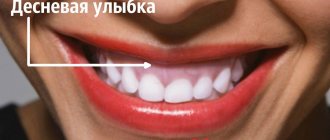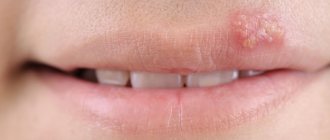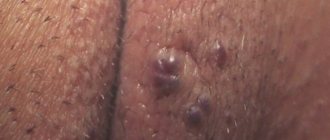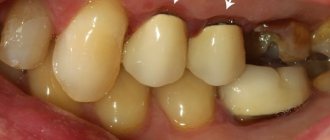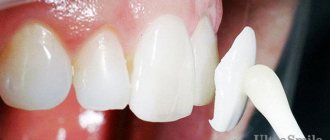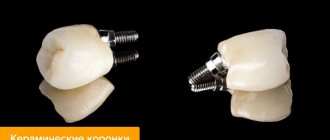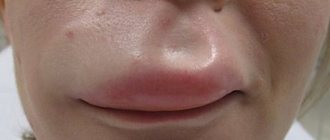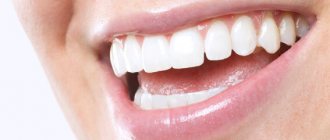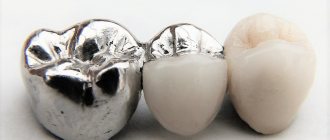Gum trimming for a gummy smile
A gummy smile is a rather unpleasant aesthetic defect. It is corrected in different ways, depending on the causes of its occurrence. For example, in case of hyperactivity of the upper lip, plastic correction of the frenulum can be performed - a very simple operation with a minimum rehabilitation period.
If there is hyperplasia (excessive growth) of the gums, then laser plastic surgery is most often recommended - a safe and almost painless procedure. After removing excess tissue, the gum contour becomes smooth and neat.
Indications for adjustments
- reduction in the volume of gingival tissue, resulting in exposure of the root tips;
- shortened teeth;
- unequal gum size;
- the presence of large gum pockets and their peeling from the surface of the dental unit;
- an inflammatory process that results in swelling and soreness of the soft tissues.
Contraindications:
- the presence of diabetes mellitus in the patient;
- period of reduced blood clotting;
- weak immunity;
- acute infectious diseases;
- cardiovascular diseases;
- patient intolerance to the anesthetic substance.
Gingivotomy: indications
Indications for gingivotomy include:
- inflammatory processes;
- preparation for dental prosthetics;
- deep periodontal pockets;
- gingival fistulas;
- abscesses, relapses of abscesses;
- periodontitis with prolonged discharge of pus;
- generalized periodontal diseases;
- the so-called gummy smile.
During the consultation, the doctor will explain whether intervention is advisable in a particular case or whether conservative treatment is possible.
Gum correction before prosthetics
As a result of tooth extraction, the volume of bone tissue changes and, accordingly, the volume of soft tissue of the mucous membrane, which leads to a change in the appearance of the jaw.
Before dental prosthetics, dentists often prescribe a gum correction procedure to the patient. The procedure involves restoring the natural contour of the gum tissue before installing dentures. In this case, it performs not only an aesthetic function, but also a barrier, preventing infection from entering the implant. In addition, it helps to prevent further exposure of the roots, reduce the likelihood of their destruction and improve the patient’s aesthetics.
The operation is performed using local anesthesia. The duration depends on the degree of damage to the area.
Lack of flush hole: consequences
In the absence of a flushing space, the consequences may be as follows:
- inflammatory processes caused by constant contact of mucous membranes with the prosthesis;
- tissue damage with subsequent exposure to pathogens;
- tissue hypertrophy in the affected areas of soft tissue.
If you look at it from a different angle, the rinsing space provokes the penetration of food into the area between the prosthesis and the mucous membrane. But without this gap, the patient will not be able to provide proper oral care. Plaque can accumulate under the bridge, so this area needs more thorough cleaning.
If the patient notes that food debris has entered the resulting space, this may be caused by incorrect installation of the prosthesis, poor quality of construction, or the development of pathologies of the oral cavity. Normally, this situation should not exist.
How to remove a crown from a tooth
Removing a crown from a tooth cannot be called a pleasant procedure, but it can be quite tolerable. Of course, for special indications it is performed under anesthesia. Now medicine offers several ways to make the process faster and less uncomfortable for the patient.
Sawing
After sawing the crown, it cannot be installed back; impressions must be taken and a new crown must be made in a dental laboratory. For the patient, the method is painless, but the doctor requires extreme concentration and attention so as not to damage the hard tissues of the tooth and soft tissues of the gums when making the cut. To prevent the tooth from overheating, the working surfaces are constantly irrigated with water during the procedure.
Dentures that need to be replaced are usually sawed. For all other cases, the dentist will select a different technique.
Ultrasound Applications
The method is based on the special reaction of the cement that attaches the crown to the tooth to ultra-high frequency sound. The adhesive material crumbles under ultrasound, and the crown is removed from the stump. But this procedure is not always effective. For example, it will not work if the crown is placed on chemically cured glass ionomer cement. When starting to work with an ultrasonic bur, the dentist often does not know what material was used to attach the crown. If there is no result, the prosthesis is removed using an alternative option.
Removing crowns using a device
If it is impossible to remove the crown manually for various reasons, the doctor uses a hardware technique to remove the prosthesis. The tools simplify the procedure and are gentle on the expensive dental attachment.
Kopp apparatus. Another name is crown remover. This tool includes a special bur that beats the cement under the crown with gentle blows. In this case, the prosthesis gradually moves away from the tooth, section by section. Then it is hooked with a special hook and removed completely.
This procedure does not cause pain to the patient. The downside of the technique is the possibility of causing damage to the crown. Sometimes the device leaves scratches on the ceramic coating of the prosthesis, and the product has to be restored.
Coronaflex device. When removing the crown, a short-term impact force (8 ms duration) is used. The device carefully removes the prosthesis, the risk of damage is reduced to zero. Often used to remove expensive zirconium dioxide crowns. The tool itself is also very expensive, so the cost of work involving it is high.
Impact force is adjustable. It is recommended to start with a minimal amount to avoid breaking the tooth and gradually increase until the crown is removed. Crowns are removed from chewing teeth using a device in the form of forceps. If the tooth is in the smile zone, a more complex system is used, using brackets. Coronaflex can also be used to remove bridges covering several teeth.
When the crown is removed from the tooth stump, the doctor begins therapeutic procedures. It is also possible to take an x-ray to evaluate the condition of the root apices and root canals. After treatment, the prosthesis is installed in its original place or replaced with a new one.
Make an appointment with a doctor at Dr. Lopaeva’s clinic
Make an appointment
Or call +7(985)532-21-01
Metal-ceramic crown or zirconium
How much do zirconium dioxide crowns cost for front teeth in Moscow?
Installing a crown on an implant in Moscow
Do they put crowns on wisdom teeth?
Treatment of a tooth under a crown without removal
The procedure for plastic correction
With any type of surgical intervention, the technology remains unchanged and consists of the following stages:
- examination of the general condition of the gums, preparation of the oral cavity for surgery: elimination of caries, plaque, tartar;
- injection of an anesthetic;
- removing or cutting part of the gum using a scalpel or laser. If there is a shortage of gum tissue, it is transplanted from another place;
- suturing.
After the procedure, the doctor prescribes further treatment and indicates recommendations that should be followed.
Technologies for gum correction before prosthetics
The choice of correction technology depends on the types of prostheses installed by the dentist for the patient. When installing a removable structure, the need for aesthetic plastic surgery of the gingival margin is eliminated due to the structure of the removable prosthesis, which consists not only of crowns, but also of artificial gum, replacing the natural one.
When installing fixed structures that do not have an artificial part, there will be a need for surgery to correct the natural gingival margin. The procedure can be carried out in three different ways.
- Gingivectomy - A surgical procedure aimed at removing part of the gum margin. The procedure is accompanied by the administration of an anesthetic. A specialist uses a surgical instrument (scalpel) to cut off a piece of mucous membrane.
- Gingivoplasty is a more complex surgical procedure that involves, in addition to excision of soft tissue, cleaning the pockets from microorganisms and purulent discharge. To do this, the gums are removed to the base of the tooth.
- Vestibulloplasty is the process of augmenting the missing part of the gum. The procedure consists of dissection, length correction and alignment of the gingival contour.
The above operations are carried out before prosthetics, usually using a surgical scalpel or laser. As a result, the patient receives a beautiful smile not only with new teeth, but also with new gums.
How to identify the problem?
If the flushing space corresponds to the norm, then:
- the prosthesis is fixed correctly;
- the gap between the bridge and the crown allows hygiene procedures to be carried out without any difficulties;
- the risk of developing periodontal pathologies is minimal;
- The device works normally for a long time.
You should consult a doctor as soon as possible if:
- after installation of the prosthesis there is noticeable discomfort or pain;
- there is a change in the location of the apparatus in the oral cavity;
- increased sensitivity to cold/hot;
- there is a burning sensation and other obvious signs of deterioration in the condition of the oral cavity.
Solution
If the gums rise or fall above the coronal part, you must consult a dentist. The doctor must take measures to restore the normal fit of the prosthesis, taking into account the distance between the structure and the surface of the oral cavity.
It is important to understand that the presence of any foreign object in the mouth is initially accompanied by discomfort, which goes away within a few days. If negative symptoms do not go away longer, you should immediately inform your doctor about this so that appropriate correction can be made.
Correction methods
- Local treatment with anti-inflammatory and antiseptic drugs (performed after removal of the orthopedic device).
- Correction of an existing prosthesis or production of a new one (the decision is made based on the results of an orthopantomogram).
- Fitting the prosthesis using the grinding method.
- Measures to strengthen supporting teeth with repeated prosthetics.
- In rare cases of the bridge coming off, which increases the risk of displacement of the supporting units, the prosthesis is reinstalled. To prevent this, it is important to consult a doctor immediately after identifying the problem.
What is gum grafting?
Gum grafting is performed in a dental office under local anesthesia. It uses both traditional scalpels and laser technologies. The doctor decides what is suitable in your particular case. Often, in order to get a general idea of the result of the procedure, before it begins, the dentist draws the contours of the future position of the gums on the teeth.
The operation is performed by a periodontist. Before deciding on a procedure, carefully select an aesthetic dentistry clinic and find out the competence of your doctor: ask him about his experience and qualifications. Always look into your dentist's continuing education and ask to see examples of work they have already done.
Stages of flap surgery on the gums
Flap surgery is necessary for severe periodontitis and periodontal disease, when periodontal pockets become too deep. For this:
- A horizontal incision is made in the gum in an area one to one and a half millimeters away from the gum margin. This flap - a thin strip of soft tissue - is removed because such damaged tissue will never be able to fit tightly to the tooth.
- Gum tissue peels off from the tooth, and the mucous membrane from the inner surface of the teeth also peels off.
- Plaque and granulation tissue accumulated in periodontal pockets are removed, and the roots are polished.
- The gums are pulled to the necks of the teeth and stitched. Sutures are placed in the interdental spaces).
Stages of flap surgery on the gums
Recovery period
Full recovery and healing of the gums may occur in a few days or weeks. To make the recovery process quick and comfortable, you must follow the following recommendations:
- For pain relief, take pain relievers as prescribed by your doctor, such as Tylenol or Advil;
- Do not take Aspirin under any circumstances, its active substances can cause bleeding;
- give up solid, hot and spicy foods for several days;
- give up cigarettes and alcoholic beverages;
- minimize active physical activity;
- Follow your doctor's advice about brushing your teeth while the tissue is healing.
How gums heal
After surgery, connections between tissues and cells are disrupted. The healing process is the formation of new physiological and anatomical connections between them.
Healing includes:
- Formation of a blood clot - forms within 5-10 minutes after surgery and serves as a protective barrier against infection and harmful microbes.
- Formation of granulation tissue - within 3-4 hours the production of granulation tissue (young connective tissue) begins.
- Epithelization and collagen formation lasts up to 7–10 days and is sometimes accompanied by slight itching.
- Regeneration and maturation - the wound “heals” after 2–3 weeks, but complete healing of the fibers requires several months.
Gum healing
How is pruning done?
The procedure can be divided into several stages :
- Professional cleaning. The gap between the crown and the gum is a place where bacteria accumulate, tartar and plaque form. Before proceeding with the operation, it is necessary to get rid of them.
- Administration of local anesthesia.
- Removal of tissues.
- Treat the surface with an antiseptic, apply a bandage with a special antibacterial solution.
The operation itself is performed using one of the following methods:
- Simple. The doctor measures the depth of the pockets and marks the level along the entire gum line. An incision is then made and a strip of gum is excised.
- Partial. This method is similar to the previous one, the only difference is that not all the tissue is excised, but only part of it in a small area.
- Radical, in which not only gum tissue is removed, but also granular tissue, and also, in some cases, altered bone. Recently, this technique is rarely used.
Both a scalpel and a laser can be used as a tool. Laser operations are less traumatic due to the fact that the beam provides not only tissue removal, but also coagulation. In addition, such procedures are non-contact, and therefore complete sterility is ensured.
WHAT ARE THE SIGNS OF GUM RECESSION?
Recession (recession) of the gums is accompanied by various symptoms. During recession, the gums become shorter, gradually exposing the roots of the teeth. Therefore, one of the first symptoms of gum recession is increased tooth sensitivity. At the same time, the teeth look longer, and there is a small groove at the edge of the gum, where it comes into contact with the tooth.
Even with these signs, you can't be sure if you have gum recession. To ensure early detection and treatment of gum disease, visit your dentist regularly. It is especially important to detect gum recession in the early stages, since timely treatment is the only way to prevent further development of the disease.
What to do after the procedure
General recommendations:
- when you arrive home, you just need to lie down and relax;
- you cannot eat or drink for 3 hours;
- for 3 days after surgery, you should not open your mouth too wide, or eat hard or hot foods;
- limit emotional and physical stress;
- hot baths, visiting the sauna, and exercising in the gym are prohibited;
- It is advisable to completely stop smoking and drinking alcohol for a week.
Remember: under no circumstances should you apply hot compresses or burn the wound with alcohol, iodine or brilliant green. It will only get worse!
A dental surgeon can prescribe applications of wound healing and antimicrobial ointments (Cholisal, Solcoseryl, Stomatofit, etc.). To strengthen general immunity, you can take immunomodulating agents and multivitamin complexes.
